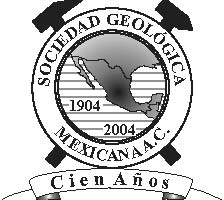|
BOLETÍN DE LA SOCIEDAD GEOLÓGICA MEXICANA VOL. 59, NÚM:. 1, 2007, p. 19-42 http://dx.doi.org/10.18268/BSGM2007v59n1a3 |
 |
Evolución geológica del sureste mexicano desde el Mesozoico al presente en el contexto regional del Golfo de México
Ricardo José Padilla y Sánchez
Universidad Nacional Autónoma de México, Facultad de Ingeniería, División en Ciencias de la Tierra, Cd. Universitaria, México D.F. 04510
This email address is being protected from spambots. You need JavaScript enabled to view it.
Abstract
The geologic evolution of southeastern Mexico is analyzed in the regional context of the Gulf of Mexico, which starts it opening with the fragmentation and spreading of Pangea. The sedimentary record in this depression begins with the deposit of continental red beds during the Late Triassic and Early Jurassic, after which, during the Callovian, sea-waters from the Pacific invaded an extense area; low circulation and high evaporation of these waters allowed the deposition of large volumes of salt in the central part of the basin. From Late Jurassic to Late Cretaceous, carbonate deposition prevailed, changing to clastic at the beginning of the Paleogene, when the Laramide Orogeny formed the folds and faults of the Sierra Madre Oriental. During the rest of the Paleogene clastic sedimentation was deposited in large depocenters generated in the foreland of the Sierra Madre Oriental, and in the southern and southwestern partsof the Golf of Mexico, where the Chiapas Massif produced large volumes of sediments, whereas in the Yucatan Block the deposition of shallow water carbonates continued. In the Middle Miocene, during the Serravalian, compressive stresses resulting from the lateral movement of the Chortis Block and the subduction of the Cocos Plate, against the southern end of the North American Plate, formed the folds and faults of the Chiapas-Reforma-Akal belt over a décollement at the level of the Callovian salt; later, these structures were tilted to the NNW when the salt was mobilized northward. The change of location of this mass of salt caused new depocenters and minibasins, comptrolled by faults with a vergence toward the deepest parts of the Gulf of Mexico, and by regional antithetic faults, which limit the Cuencas del Sureste. The gravitational movement of the Cenozoic deposits, finally caused tectonic inversion in the neogene basins, from which the most evident is the Macuspana Basin.
Keywords: Anegada High, Reforma-Campeche Folded Belt, Comalcalco Basin, Macuspana Basin, Veracruz Basin, Salina del Istmo Basin, Cuencas del Sureste, Gulf of Mexico, Gulf of Mexico geologic evolution, Tamaulipas-Oaxaca Transform Fault, Chiapas-Reforma-Akal Belt, Goleen Lane Horst, Reforma-Akal Horst, Boquillas-Sabinas Lineament, Sierra Mojada-China Lineament, Chiapas Massif, Akal High, Sierra de Chiapas, Sierra de Zongolica, Sierra Madre Oriental, Gulf of Mexico tectonics.

